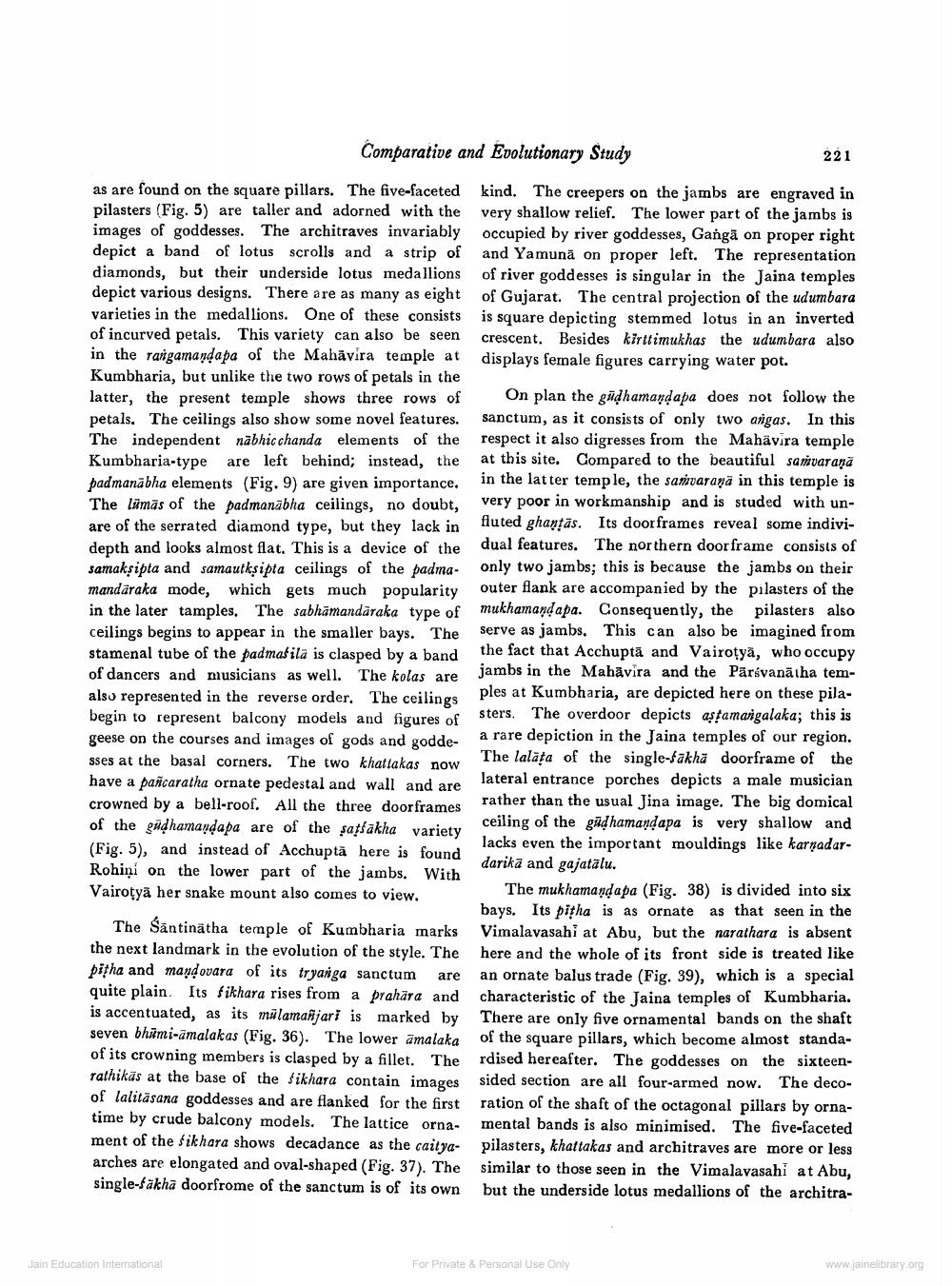________________
Comparative and Evolutionary Study
as are found on the square pillars. The five-faceted pilasters (Fig. 5) are taller and adorned with the images of goddesses. The architraves invariably depict a band of lotus scrolls and a strip of diamonds, but their underside lotus medallions depict various designs. There are as many as eight varieties in the medallions. One of these consists of incurved petals. This variety can also be seen in the rangamandapa of the Mahavira temple at Kumbharia, but unlike the two rows of petals in the latter, the present temple shows three rows of petals. The ceilings also show some novel features. The independent nabhic chanda elements of the Kumbharia-type are left behind; instead, the padmanabha elements (Fig. 9) are given importance. The lumas of the padmanabha ceilings, no doubt, are of the serrated diamond type, but they lack in depth and looks almost flat. This is a device of the samakṣipta and samautkṣipta ceilings of the padmamandāraka mode, which gets much popularity in the later tamples. The sabhamandāraka type of ceilings begins to appear in the smaller bays. The stamenal tube of the padmašila is clasped by a band of dancers and musicians as well. The kolas are also represented in the reverse order. The ceilings begin to represent balcony models and figures of geese on the courses and images of gods and goddesses at the basal corners. The two khattakas now have a pancaratha ornate pedestal and wall and are crowned by a bell-roof. All the three doorframes of the gūḍhamaṇḍapa are of the saffakha variety (Fig. 5), and instead of Acchupta here is found Rohini on the lower part of the jambs. With Vairotyä her snake mount also comes to view.
are
The Santinatha temple of Kumbharia marks the next landmark in the evolution of the style. The pitha and mandovara of its tryanga sanctum quite plain. Its fikhara rises from a prahara and is accentuated, as its mulamanjari is marked by seven bhimi-amalakas (Fig. 36). The lower amalaka of its crowning members is clasped by a fillet. The rathikas at the base of the sikhara contain images of lalitasana goddesses and are flanked for the first time by crude balcony models. The lattice ornament of the fikhara shows decadance as the caityaarches are elongated and oval-shaped (Fig. 37). The single-fakha doorfrome of the sanctum is of its own
Jain Education International
221
kind. The creepers on the jambs are engraved in very shallow relief. The lower part of the jambs is occupied by river goddesses, Ganga on proper right and Yamuna on proper left. The representation of river goddesses is singular in the Jaina temples of Gujarat. The central projection of the udumbara is square depicting stemmed lotus in an inverted crescent. Besides kirttimukhas the udumbara also displays female figures carrying water pot.
On plan the guḍhamandapa does not follow the sanctum, as it consists of only two angas. In this respect it also digresses from the Mahavira temple at this site. Compared to the beautiful samvarana in the latter temple, the samvarana in this temple is very poor in workmanship and is studed with unfluted ghantas. Its door frames reveal some individual features. The northern doorframe consists of only two jambs; this is because the jambs on their outer flank are accompanied by the pilasters of the mukhamandapa. Consequently, the pilasters also serve as jambs. This can also be imagined from the fact that Acchuptă and Vairotyä, who occupy jambs in the Mahavira and the Pärsvanatha temples at Kumbharia, are depicted here on these pilasters. The overdoor depicts aṣṭamangalaka; this is a rare depiction in the Jaina temples of our region. The lalata of the single-fakha doorframe of the lateral entrance porches depicts a male musician rather than the usual Jina image. The big domical lacks even the important mouldings like karṇadarceiling of the gudhamanḍapa is very shallow and darika and gajatālu.
The mukhamandapa (Fig. 38) is divided into six bays. Its pitha is as ornate as that seen in the Vimalavasahi at Abu, but the narathara is absent here and the whole of its front side is treated like an ornate balus trade (Fig. 39), which is a special characteristic of the Jaina temples of Kumbharia. There are only five ornamental bands on the shaft of the square pillars, which become almost standardised hereafter. The goddesses on the sixteensided section are all four-armed now. The decoration of the shaft of the octagonal pillars by ornamental bands is also minimised. The five-faceted pilasters, khattakas and architraves are more or less similar to those seen in the Vimalavasahi at Abu, but the underside lotus medallions of the architra
For Private & Personal Use Only
www.jainelibrary.org




